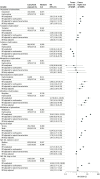Characteristics of Prescription Opioid Analgesics in Pregnancy and Risk of Neonatal Opioid Withdrawal Syndrome in Newborns
- PMID: 36001312
- PMCID: PMC9403776
- DOI: 10.1001/jamanetworkopen.2022.28588
Characteristics of Prescription Opioid Analgesics in Pregnancy and Risk of Neonatal Opioid Withdrawal Syndrome in Newborns
Abstract
Importance: Prescription opioids are often used during pregnancy even though they are associated with neonatal opioid withdrawal syndrome (NOWS). Most studies of adverse outcomes of opioid use for pain have assessed only the class-wide outcome despite the pharmacodynamic and pharmacokinetic heterogeneity across opioid medications.
Objective: To compare the risk of NOWS across common types of opioids when prescribed as monotherapy during the last 3 months of pregnancy.
Design, setting, and participants: This cohort study analyzed administrative claims data of Medicaid-insured mothers and newborns in 46 states and Washington DC from January 1, 2000, through December 31, 2014. Participants were mothers with 2 or more dispensed opioid prescriptions within 90 days before delivery and their eligible live-born neonates. Data were analyzed from February 2020 to March 2021.
Exposure: Different types of opioid medications were compared by agonist strength (strong vs weak) and half-life (medium vs short and long vs short) of the opioid active ingredient.
Main outcomes and measures: The primary outcome was NOWS, which was identified using an International Classification of Diseases, Ninth Revision, Clinical Modification diagnostic code in the 30 days after delivery. Relative risks (RRs) were adjusted for an exposure propensity score, including demographic characteristics, comorbidities, other medication use, and opioid treatment characteristics (including morphine milligram equivalents), using fine stratification.
Results: The cohort comprised 48 202 opioid-exposed pregnancies with live newborns. A total of 1069 neonates (2.2%) had NOWS and 559 (1.2%) had severe NOWS. Opioid exposure during pregnancy included 16 202 pregnancies exposed to codeine, 4540 to oxycodone, 1244 to tramadol, 260 to methadone (dispensed for pain), 90 to hydromorphone, and 63 to morphine compared with 25 710 exposed to hydrocodone. Demographic characteristics varied across opioids, with tramadol, oxycodone, methadone, hydromorphone, and morphine being more commonly dispensed at older maternal age (≥35 years). Compared with hydrocodone, codeine had a lower adjusted RR of NOWS (0.57; 95% CI, 0.46-0.70), with a similar adjusted RR for tramadol (RR, 1.06; 95% CI, 0.73-1.56), and 2- to 3-fold higher adjusted RRs for oxycodone (1.87; 95% CI, 1.66-2.11), morphine (2.84; 95% CI, 1.30-6.22), methadone (3.02; 95% CI, 2.45-3.73), and hydromorphone (2.03; 95% CI, 1.09-3.78). Strong agonists were associated with a higher risk of NOWS than weak agonists (RR, 1.97; 95% CI, 1.78-2.17), and long half-life opioids were associated with an increased risk compared with short half-life products (RR, 1.33; 95% CI, 1.12-1.56). Findings were consistent across sensitivity and subgroup analyses.
Conclusions and relevance: Results of this study show higher risk of NOWS and severe NOWS among neonates with in utero exposure to strong agonists and long half-life prescription opioids. Information on the opioid-specific risk of NOWS may help prescribers select opioids for pain management in late stages of pregnancy.
Conflict of interest statement
Figures




Similar articles
-
Florida Controlled Substance Prescribing.2022 Oct 26. In: StatPearls [Internet]. Treasure Island (FL): StatPearls Publishing; 2025 Jan–. 2022 Oct 26. In: StatPearls [Internet]. Treasure Island (FL): StatPearls Publishing; 2025 Jan–. PMID: 33428370 Free Books & Documents.
-
NP Safe Prescribing of Controlled Substances While Avoiding Drug Diversion.2023 Jan 29. In: StatPearls [Internet]. Treasure Island (FL): StatPearls Publishing; 2025 Jan–. 2023 Jan 29. In: StatPearls [Internet]. Treasure Island (FL): StatPearls Publishing; 2025 Jan–. PMID: 33232099 Free Books & Documents.
-
Newborn Cry Acoustics in the Assessment of Neonatal Opioid Withdrawal Syndrome Using Machine Learning.JAMA Netw Open. 2022 Oct 3;5(10):e2238783. doi: 10.1001/jamanetworkopen.2022.38783. JAMA Netw Open. 2022. PMID: 36301544 Free PMC article.
-
Neonatal opioid toxicity: opioid withdrawal (abstinence) syndrome with emphasis on pharmacogenomics and respiratory depression.Arch Toxicol. 2023 Oct;97(10):2575-2585. doi: 10.1007/s00204-023-03563-8. Epub 2023 Aug 3. Arch Toxicol. 2023. PMID: 37537419 Review.
-
Opioids, Opioid Antagonists.2020 Nov 24. LiverTox: Clinical and Research Information on Drug-Induced Liver Injury [Internet]. Bethesda (MD): National Institute of Diabetes and Digestive and Kidney Diseases; 2012–. 2020 Nov 24. LiverTox: Clinical and Research Information on Drug-Induced Liver Injury [Internet]. Bethesda (MD): National Institute of Diabetes and Digestive and Kidney Diseases; 2012–. PMID: 31643200 Free Books & Documents. Review.
Cited by
-
Prenatal opioid use disorder and child protective service involvement: Does consistent treatment matter?J Subst Use Addict Treat. 2025 May;172:209681. doi: 10.1016/j.josat.2025.209681. Epub 2025 Mar 20. J Subst Use Addict Treat. 2025. PMID: 40120812
-
Placental transcriptome analysis in opioid-exposed versus non-opioid exposed pregnancies.Placenta. 2025 Mar 25;162:27-34. doi: 10.1016/j.placenta.2025.02.012. Epub 2025 Feb 17. Placenta. 2025. PMID: 39983471
-
Pharmacotherapy research landscape and knowledge gaps of opioids in maternal and pediatric populations.Pharmacotherapy. 2025 Jun;45(6):367-385. doi: 10.1002/phar.70024. Epub 2025 May 15. Pharmacotherapy. 2025. PMID: 40371673 Free PMC article. Review.
-
Prenatal opioid exposure and risk of asthma in childhood: a population-based study from Denmark, Norway, and Sweden.Front Pharmacol. 2023 May 4;14:1056192. doi: 10.3389/fphar.2023.1056192. eCollection 2023. Front Pharmacol. 2023. PMID: 37214456 Free PMC article.
-
Prescription Opioid Exposure During Pregnancy and Risk of Spontaneous Preterm Delivery.JAMA Netw Open. 2024 Feb 5;7(2):e2355990. doi: 10.1001/jamanetworkopen.2023.55990. JAMA Netw Open. 2024. PMID: 38353951 Free PMC article.
References
-
- Cohen B, Ruth LJ, Preuss CV. Opioid analgesics. In: StatPearls [Internet]. StatPearls Publishing; 2022. - PubMed

